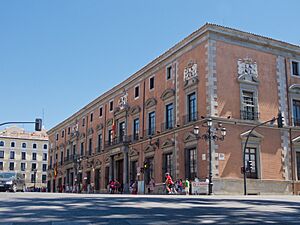Cristóbal Gómez de Sandoval, 1st Duke of Uceda facts for kids
Cristóbal Gómez de Sandoval-Rojas y de la Cerda, often called the Duke of Uceda, was an important minister for King Philip III of Spain. He was known as the valido, which means a trusted advisor or favorite. He took over this powerful role after his father, the Duke of Lerma, was sent away from the royal court.
Contents
Who Was the Duke of Uceda?
Early Life and Family
Cristóbal Gómez de Sandoval was the son of Francisco Gómez de Sandoval y Rojas, the first Duke of Lerma. His mother was Catalina de la Cerda, who was a main lady-in-waiting for Queen Margaret of Austria. Cristóbal was born around 1577 to 1581.
In 1597, Cristóbal married Mariana de Padilla Manrique. Her father was Martín de Padilla Manrique, the first Count of Santa Gadea. Her mother was Luisa Manrique de Lara. Cristóbal and Mariana had seven children, but only three lived to be adults:
- Luisa Gómez de Sandoval-Rojas y Padilla, who married Juan Alfonso Enríquez de Cabrera.
- Isabel Gómez de Sandoval-Rojas y Padilla, who married Juan Tellez-Girón y Enriquez de Ribera, 4th Duke of Osuna.
- Francisco Gómez de Sandoval-Rojas y Padilla, who later became the second Duke of Uceda. He married Felice Enríquez de Cabrera.
Rise to Power
In 1609, Cristóbal bought the town of Uceda. The next year, the King gave him the special title of Duke of Uceda.
Cristóbal wanted to take his father's place as the King's main advisor. He worked with people who also disliked his father, the Duke of Lerma. These people included the King's religious advisor, Luis de Aliaga, and a powerful nobleman named Gaspar de Guzmán, Count-Duke of Olivares.
In 1618, the Duke of Lerma lost the King's favor because many people did not like him. He was then made a cardinal and given duties outside of Madrid. This cleared the way for Cristóbal to become the new valido.
Time as a Minister
As the Duke of Uceda, Cristóbal was given important jobs like being the King's chief chamberlain (Sumiller de Corps) and master of the horse (Caballerizo mayor). He made decisions that helped rich landowners, including his own family. He also built a very grand building in Madrid called the Palacio of the Duke of Uceda.
In foreign policy, he continued to support the King's efforts to stop a religious rebellion in Bohemia. He also wanted to bring Portugal under Spanish rule.
Fall from Power
In 1621, King Philip III died, and his son Philip IV of Spain became the new King. The Duke of Uceda was soon replaced by his former ally, the Count-Duke of Olivares.
Like his father, Cristóbal was sent away from the royal court. He was exiled to a castle in Torrejón de Velasco. Much of his property was taken away. He was briefly set free and pardoned, but then he was arrested again. He died in jail in Alcalá de Henares on May 31, 1624.
See also
 In Spanish: Cristóbal Gómez de Sandoval y de la Cerda para niños
In Spanish: Cristóbal Gómez de Sandoval y de la Cerda para niños




